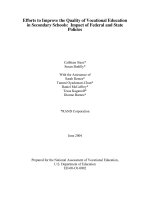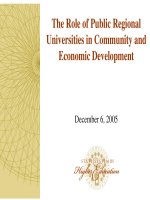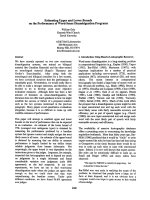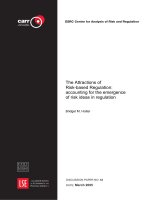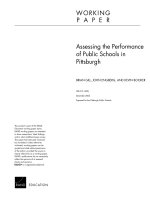Assessing the Performance of Public Schools in Pittsburgh docx
Bạn đang xem bản rút gọn của tài liệu. Xem và tải ngay bản đầy đủ của tài liệu tại đây (231.12 KB, 24 trang )
Assessing the Performance
of Public Schools in
Pittsburgh
BRIAN GILL, JOHN ENGBERG, AND KEVIN BOOKER
WR-315-1-EDU
December 2005
Prepared for the Pittsburgh Public Schools
WORKING
P A P E R
This product is part of the RAND
Education working paper series.
RAND working papers are intended
to share researchers’ latest findings
and to solicit additional peer review.
This paper has been peer reviewed
but not edited. Unless otherwise
indicated, working papers can be
quoted and cited without permission
of the author, provided the source is
clearly referred to as a working paper.
RAND’s publications do not necessarily
reflect the opinions of its research
clients and sponsors.
is a registered trademark.
1
Assessing the Performance of Public Schools in Pittsburgh
Brian Gill, John Engberg, and Kevin Booker
The RAND Corporation
2 December 2005
1
Summary
To assist the Pittsburgh Public Schools (PPS) in decisionmaking about the realignment
and closure of schools, RAND addressed three key issues by analyzing student-level
achievement data in the district. First, we examined achievement gains in the middle
grades (6-8), finding that students in Pittsburgh’s K-8 schools and magnet middle schools
generally outgain students in Pittsburgh’s comprehensive, feeder middle schools. K-8
schools in Pittsburgh appear to be especially beneficial for the achievement of African-
American students, at least in grades 6 and 7. Second, we created an index of Average
Student Achievement (ASA) in each school in the district, combining results across tests,
subjects, and grades, and anchoring the index to proficiency results on the Pennsylvania
System of Student Assessment (PSSA). The ASA index provides a simple but robust
composite snapshot of current levels of student achievement in each school. Third,
RAND developed a School Performance Index that uses statistical regression techniques
and longitudinal analyses of the achievement of individual students over time to estimate
each school’s contribution to the achievement growth of its students. The SPI is being
used by the district to ensure that decisions about school closings and realignments are
made in ways that maintain and promote strong educational offerings for Pittsburgh
students. This report concludes with SPI ratings for each school in Pittsburgh.
1
This is a slightly revised version of a WR that originally was released on 9 November 2005.
Performance of Public Schools in Pittsburgh RAND WR-315-1-EDU
2-Dec-05 2
Introduction
Declining enrollments and structural budget deficits are facing the Pittsburgh Public
Schools (PPS). The district has a portfolio of school buildings constructed for a student
population that, a decade ago, was substantially larger than it is today or will be in the
foreseeable future. Half a dozen elementary schools in Pittsburgh enroll fewer than 200
students, and many buildings are similarly below capacity at middle-school and high-
school levels. In short, closing schools is imperative for the long-term financial health of
the district.
Recognizing that financial considerations are not the only ones that are relevant in the
decisions that must be made to close schools, Superintendent Mark Roosevelt appointed a
committee to consider how to realign schools in a way that would not only save
resources, but also better serve the academic needs of students across Pittsburgh.
Closing schools can have substantial impacts on students, families, and neighborhoods.
PPS intends to make closing decisions that will consider, first of all, the effect on student
achievement. Schools must be closed while maintaining and improving the educational
programs offered to all students in the district, including those who may be displaced by
the closures. In particular, the realignment committee agreed on two key principles
related to student achievement and school performance:
1. High-performing schools will be kept open so long as they enroll a sufficient
number of students that they are able to operate with a fair and equitable amount
of resources.
Performance of Public Schools in Pittsburgh RAND WR-315-1-EDU
2-Dec-05 3
2. Students who are asked to move as a result of school closings will have the
opportunity to move to equal- or higher-performing schools, or to schools that are
given substantially enhanced educational programs.
2
Superintendent Roosevelt asked RAND to assist the realignment committee in creating a
plan for school realignments and closures. Over the past six weeks, RAND’s work with
the district and the committee has included a comprehensive, school-by-school
examination of student achievement and school performance.
To meet the district’s goals, PPS and the realignment committee needed good
information about average student achievement and about school performance in schools
across the district. In addition, the committee wanted to know whether K-8 schools or
middle schools were producing larger achievement gains, as it considered possible
variations in grade configurations around the district.
This paper describes how RAND addressed these issues and presents the findings of
RAND’s achievement analyses for the committee. Ultimately, RAND created two new
indices: one measures average student achievement at each school in the district, while
the other attempts to measure school performance—i.e., the contribution that each school
is making toward raising the achievement of its students. These indices should be useful
not only for the realignment process, but also for the district’s emerging plan to improve
the performance of all of Pittsburgh’s public schools.
2
In particular, PPS is developing models for “Accelerated Learning Academies” that will involve
an infusion of resources for additional class time, enhanced professional development, and other
strategies for instructional improvement.
Performance of Public Schools in Pittsburgh RAND WR-315-1-EDU
2-Dec-05 4
The paper is organized as follows: It first describes the analysis of the relative
achievement growth in different kinds of schools serving grades 6-8. It then describes
the development of two new indices, one measuring average student achievement and the
other measuring school performance. It concludes with school-by-school performance
results for schools across Pittsburgh.
Achievement in the middle grades
Over the past decade, PPS has converted a handful of K-5 elementary schools to K-8
schools, usually at the instigation of neighborhood advocacy groups. PPS currently
serves students in the elementary and middle grades through a patchwork of schools in K-
5, 6-8, and K-8 configurations. Each configuration includes some “feeder” schools for
which assignment is determined primarily by residential attendance zones and some
magnet schools that offer particular educational emphases (e.g. foreign language, fine
arts) and enroll students by choice, districtwide.
The middle grades are viewed as a particularly challenging time for students (see
Juvonen et al, 2004), and public dissatisfaction with middle schools in Pittsburgh is
symptomatic of increasing challenges to the middle-school concept around the country.
Some urban school districts have been closing down middle schools in favor of K-8
schools on a variety of educational grounds (see George, 2005). A few studies have
found positive effects of K-8 schools (as compared with middle schools), including
longer-term relationships between students and school staff, better student behavior, the
Performance of Public Schools in Pittsburgh RAND WR-315-1-EDU
2-Dec-05 5
reduction of achievement dips resulting from transition to a new school, and improved
test scores (see Anfara and Buehler, 2005, for a summary of research).
We use longitudinal, student-level achievement data from the district’s “Real-Time
Information” (RTI) database to assess differences in achievement growth from fifth grade
to eighth grade for students attending middle schools and K-8s in Pittsburgh. We
separately examine feeder schools and magnet schools, and separately examine the
achievement of black students and white students (because the population of the
Pittsburgh Public Schools consists almost entirely of those two racial groups).
3
For this
analysis and the remaining analyses in the paper, we convert all student test scores into
standardized measures to create some comparability across different tests used in
different grades.
4
PPS uses the Pennsylvania System of Student Assessment (PSSA) in
grades 3, 5, 8, and 11, and the Terra Nova and New Standards Reference Exams
interspersed in other grades (see Gill and Engberg, 2005). Because our inquiries for these
purposes are not subject-specific, we average each student’s score across reading and
math.
To assess achievement gains in the different types of schools serving middle-grade
students in Pittsburgh, we examine students’ test results in grades six, seven, and eight,
controlling for their fifth-grade test results and for age, gender, family structure (two-
3
As of 2004-05, 57% of the enrollment of K-8 schools in Pittsburgh was African-American,
approximately equivalent to the proportion of African-American students across PPS.
4
Specifically, we sort all student scores by rank and then convert them to rank-based z-scores,
normed across the entire population of tested students in that subject and grade. This cannot
create a psychometrically valid developmental scale, but it permits an examination of changes in
rank with fewer assumptions than would be needed under other kinds of scaling. See the
appendices of Gill et al (2005) for further discussion of rank-based z-scores.
Performance of Public Schools in Pittsburgh RAND WR-315-1-EDU
2-Dec-05 6
parent household, single-parent household, or no-parent household), poverty, special
education status, gifted status, and English-language learner status. The most important
of these controls is the fifth-grade score, which allows us to factor out students’ prior
achievement, implicitly creating a measure of the gain in achievement of each student
between fifth grade and sixth grade, fifth grade and seventh grade, and fifth grade and
eighth grade. The additional controls help to account for the possibility that student
background characteristics may affect achievement growth trajectories as well as
achievement levels.
The results suggest that students in Pittsburgh’s feeder middle schools experience the
transitional dip in achievement that has been observed elsewhere, as indicated in Table 1,
which shows the achievement advantage of K-8 schools in each of grades six through
eight . Relative to their fifth-grade achievement (and controlling for the student
characteristics described above), students in PPS feeder middle schools fall behind their
counterparts in feeder K-8 schools in sixth grade, on average. For both white students
and African-American students, the sixth-grade advantage of feeder K-8 schools over
feeder middle schools is statistically significant.
Table 1: Achievement Advantage of K-8 Feeder Schools vs. Feeder Middle Schools
Grade White students
African-American
students
6 .070** .123***
7 .037 .156***
8 .075 .028
*** p-val < .01 ** p-val < .05 * p-val < .10
For both white students and African-American students, K-8 schools retain a small
Performance of Public Schools in Pittsburgh RAND WR-315-1-EDU
2-Dec-05 7
average achievement advantage through eighth grade, although the advantage is not
always statistically significant. In both sixth grade and seventh grade, the K-8 advantage
over feeder middle schools is larger for African-American students. This might occur
because the K-8 configuration has particular benefits for African-American students, or
because African-American students in Pittsburgh attend especially low-performing
middle schools.
The absence of statistically significant differences in eighth grade between K-8 feeder
schools and feeder middle schools means we cannot be sure whether there is a sustained,
long-term advantage for the K-8 schools. Nevertheless, these findings are sufficiently
promising that the realignment committee believed it would be appropriate to convert
more of Pittsburgh’s K-5 schools to K-8 schools.
Students in magnet middle schools also show higher achievement in grades 6-8 from
fifth-grade baselines, controlling for student background characteristics, as indicated in
Table 2.
Table 2: Achievement Advantage of Magnet Middle Schools vs. Feeder Middle Schools
Grade White students
African-American
students
6 .072*** .083***
7 .100*** .121***
8 .084*** .097***
*** p-val < .01 ** p-val < .05 * p-val < .10
These results should be interpreted with caution, because magnet students are self-
selected—they (or their parents) choose to attend magnets. It is possible that magnet
Performance of Public Schools in Pittsburgh RAND WR-315-1-EDU
2-Dec-05 8
students would show larger achievement gains regardless of whether they were in
magnets elsewhere. Nevertheless, the results provide support for the view that
Pittsburgh’s middle-grade students are being served better by K-8s and magnet middle
schools than by feeder middle schools.
5
Average results in grades six through eight of
Pittsburgh’s two K-8 magnet schools (Carmalt and Homewood Montessori) are likewise
superior to those of feeder middle schools.
It is important to recognize that all of these results are averages that are summed across
Pittsburgh’s feeder middle schools, magnet middle schools, and feeder K-8 schools. As
the next section of this report shows, there is considerable variation in the achievement
growth shown in individual K-8 schools and middle schools across PPS. Some feeder
middle schools are doing well, and some K-8 schools are not. Recognizing this, the
realignment committee chose not to take a “one size fits all” approach, in preserving
some feeder middle schools while recommending the closure of several feeder middle
schools that showed weak achievement growth.
Measuring schools’ average student achievement
This section describes how we analyze PPS data to produce a composite index of average
student achievement in each school. Publicly available measures of achievement levels
in individual schools in Pittsburgh have until now been limited to reports of the
percentage of students achieving proficiency on the state’s PSSA tests in grades 3, 5, 8,
and 11. In small schools, these results can vary substantially from year to year,
5
It is possible that the existing K-8 schools were higher-performing schools even when they were
K-5 schools; data are not available to examine this possibility systematically.
Performance of Public Schools in Pittsburgh RAND WR-315-1-EDU
2-Dec-05 9
depending on the characteristics of the particular cohorts of students in the relevant
grades in that year. We use the district’s student-level data on PSSA scores as well as
Terra Nova and New Standards results in other grades to create a school-level index of
Average Student Achievement (ASA). The ASA index is more robust than PSSA
proficiency results alone because it includes a larger number of students in each school
and because it includes varied assessments that together measure a wider range of skills
and knowledge than would be included on a single assessment.
As the first step in creating the ASA, results from each test in each grade are sorted by
students to create rankings, which are in turn converted to normal distributions across
PPS. We then aggregate standardized student-level results separately in each school.
Finally, we anchor the school-level results to the PSSA by assigning the highest- and
lowest-achieving schools at each level (elementary, middle, and high) a number on a 100-
point scale corresponding to the proportion of their students who achieved proficiency on
the PSSA, averaged across reading and math. Thus, for the highest- and lowest-
achieving schools in the district at each level (identified based on average results across
all grades and tests, in both reading and math), their ASA index results are identical to
their PSSA proficiency results. The remaining schools are given ASA numbers based on
their positions in the district’s overall distribution between the highest- and lowest-
achieving schools. For most schools, ASA numbers are not identical to PSSA
proficiency results, but the two measures are correlated.
As a measure of average achievement across a school, the ASA index is not identical to a
Performance of Public Schools in Pittsburgh RAND WR-315-1-EDU
2-Dec-05 10
measure of the proportion of students achieving proficiency. Rather than merely
examining the percentage of students who achieve a specified cut score on an exam, the
ASA incorporates information about the total distribution in achievement of all students
in each school. It therefore accounts for differences across schools in the achievement of
very high- and very low-achieving students as well as differences in achievement of
students whose scores place them near the cut point that the state has defined as
proficiency.
Although ASA is a measure of average achievement rather than a count of students
achieving a cut score, we nevertheless believe it is useful to anchor the ASA scale to
PSSA proficiency results. Tying the ASA scale to the proportion of students who are
proficient on the PSSA allows each school to be assessed relative to an external standard
of achievement. In the absence of such a tie, the ASA index would be useful for
comparing relative achievement levels of schools within Pittsburgh, but it would not
permit comparison to an objective standard of achievement. Because PSSA proficiency
has been defined by the state as the relevant standard for public-policy purposes, and
because the proficiency levels are widely recognized in Pennsylvania, it is the most
appropriate external anchor for the ASA.
In Pittsburgh, the school with the highest level of student achievement across all tests has
an average of 80% of its students achieving proficiency on the PSSA. It therefore has an
ASA of 80. The school with the lowest level of student achievement across all tests has
an average of 13% of its students achieving proficiency on the PSSA. It therefore has an
Performance of Public Schools in Pittsburgh RAND WR-315-1-EDU
2-Dec-05 11
ASA of 13. The remainder of the schools in Pittsburgh have ASA numbers between 13
and 80, corresponding to their positions in relative levels of average student achievement
across the district.
6
Figure 1 shows the distribution of ASA numbers in individual
schools across the district. The appendix at the end of this report includes ASA results
for specific schools.
Figure 1: Average Student Achievement Across Schools in Pittsburgh
The ASA provides a robust measure of student achievement levels in each school in
Pittsburgh. ASA results should be useful to the district and to the public for purposes of
providing a snapshot of the varying academic needs of students in schools around
6
The anchoring to PSSA scores is actually conducted separately at each school level (elementary,
middle, and high). Readers should therefore use caution in comparing ASA results for schools
serving different grade levels. ASA results are comparable across school levels only to the extent
that PSSA proficiency results are comparable across school levels.
0
10
20
30
40
50
60
70
80
90
100
Schools
Performance of Public Schools in Pittsburgh RAND WR-315-1-EDU
2-Dec-05 12
Pittsburgh. ASA results should not, however, be interpreted as measures of the
performance of schools. Achievement levels are a product not only of school
performance, but also of a wide range of other forces that are outside the control of
schools, including family, peer, and neighborhood characteristics. Understanding the
average level of achievement in a school is therefore not equivalent to understanding the
school’s contribution to student achievement. We examine school performance in the
next section.
Measuring school performance
This section describes the analyses RAND conducted with the aim of identifying the
school’s contribution to student achievement, thereby measuring the performance of the
school.
A methodologically valid measure of school performance is one that fairly assesses the
educational value that the school provides to its students, independent of family and
neighborhood factors. Because students are not randomly assigned to schools, there is no
way to perfectly distinguish the effects of schools from the effects of non-school factors.
Nevertheless, careful analysis of student-level data can go a long way toward identifying
school effects—thereby providing considerable guidance to policymakers and the public
about school performance. We use three different methods of analyzing school effects,
combining them to create a School Performance Index.
First, we conduct a multivariate statistical regression that examines individual test scores
Performance of Public Schools in Pittsburgh RAND WR-315-1-EDU
2-Dec-05 13
across the district for all grades and subjects, controlling for student background variables
including poverty, special education status, family structure, gifted status, English-
language learner status, race, and mobility. Each school is entered into the regression as
its own variable, and the resulting coefficient for each school is interpreted as that
school’s effect. Although this method does not directly examine student achievement
gains over time, it uses districtwide information on the effects of the various background
variables to account for differences in the preparation levels of students who enroll at
different schools around Pittsburgh. The results are intended to be comparable across
schools as if they were serving similar populations of students.
Second, we use the longitudinal data on individual students to conduct a quasi-
experimental, “within-student” analysis that compares results for individual students who
are enrolled in different schools in different years. Students move either because of
structural transitions (from elementary to middle school or middle to high school) or
because they transfer. In either case, the ability to observe individual students in different
schools creates an opportunity to distinguish the school’s effect from the effect of fixed
student background characteristics, regardless of whether those characteristics are
adequately measured by the demographic information available to us. If, for example, a
student who had low achievement in elementary school has higher achievement after
moving to middle school (and if this happens systematically for substantial numbers of
students), we have evidence that the middle school is a higher-performing school.
Third, for schools serving grades 6-12 we also use the longitudinal data to assess the
Performance of Public Schools in Pittsburgh RAND WR-315-1-EDU
2-Dec-05 14
gains that students make over the course of three years. For middle schools and K-8
schools, we compare average gains for students from grade 5 to grade 8. For high
schools, we compare average gains for students from grade 8 to grade 11. Like the
preceding analysis, this analysis helps to identify school effects by factoring out a
student’s previous achievement (although student background characteristics may affect
gains over time, so the analysis is not definitive). Such an analysis is impossible for
grades K-5 because we have no pre-kindergarten measures of student achievement to use
as baseline scores. The PPS data system includes achievement results for grades 1-3 only
for the last two years. In the future, when sufficient data become available, it may be
useful to examine gains from first grade to fifth grade for elementary schools.
Although none of these three methods of identifying a school’s effect on student
achievement is definitive, they have complementary strengths and limitations, and
together they can create a better estimate of school performance than average
achievement or proficiency results can provide. The first approach, using cross-sectional
statistical regression analysis, may not completely capture all of the relevant background
differences across students, but it is more comprehensive and current than the other
analyses because it includes results for every student tested in each school in 2005. The
second approach provides better controls for the effects of unobserved student
background characteristics, but it examines only the subset of students who have
appeared in more than one school, and it requires an assumption that school effects do not
carry over after a student enrolls in a new school.
7
The third approach—examining three-
7
The value of this method is also limited by the fact that students are not randomly distributed
when they move from elementary school to middle school and from middle school to high school,
Performance of Public Schools in Pittsburgh RAND WR-315-1-EDU
2-Dec-05 15
year gains—effectively controls for prior achievement levels (but not gains) while
requiring several years of data on each student, thus limiting the number of students that
can be included. For purposes of assessing school performance, all three methods are
superior to simply examining average student achievement (or proficiency), because all
three methods seek to distinguish the school’s contribution to student achievement from
the contribution of out-of-school factors.
Results from each of the three analyses are initially calculated in terms of the same rank-
based standardized measures that are used for the ASA index. But the cross-sectional
results are not directly comparable to the gain results, so we convert results from all three
analyses into normal curve equivalent (NCE) scores, which are scaled in a way that
permits averaging. We weight the results of the three analyses as follows:
• For schools serving grades 6-12, adjusted cross-sectional results are weighted
50%, quasi-experimental within-student results are weighted 25%, and three-year
gain results are weighted 25%
• For elementary schools serving grades K-5, adjusted cross-sectional results are
weighted 75% and quasi-experimental within-student results are weighted 25%
Although we believe that these weights produce results that appropriately consider the
strengths and weaknesses of each analysis, these are not the only possible ways to weight
the results of the different analyses. In order to reduce the significance of weighting
as follows. If school performance is correlated across school levels within feeder patterns, the
“within-student” method may underestimate school effects. High-performing elementary
schools, for example, won’t look quite as high-performing if they feed to high-performing middle
schools.
Performance of Public Schools in Pittsburgh RAND WR-315-1-EDU
2-Dec-05 16
decisions and to avoid overstating the precision of our results, we convert the results to a
four-point scale. For most schools, the results of the different analyses are well
correlated, so that alternative weighting decisions would produce few differences in
results on the four-point scale. Such a scale is reasonably robust to different weighting
decisions and to variations in results across the three methods of analysis.
Superintendent Roosevelt and the realignment committee believe that the top score on the
scale should be reserved for schools that not only produce substantial gains for the
students they serve, but that also bring their students to high absolute levels of
achievement. Initial discussions with the Board of Education of the Pittsburgh Public
Schools suggest that they, too, support the idea that the top rating should designate
schools that excel both in terms of student gains and in terms of external standards of
student achievement. In consequence, we have proposed a School Performance Index
(SPI) on a five-point scale. The first four points will be based on the results of the
analyses described above. Schools that earn four points on the statistically adjusted and
gain measures will be eligible to earn a fifth point—the top rating—if they also achieve a
minimum threshold of absolute achievement on the ASA scale, for black students and
white students, low-income students and non-low-income students. Setting the standard
for that threshold is a policy decision rather than a research question. We expect that the
PPS board and staff will engage in a discussion about appropriate standards for “five-
star” schools in the near future. In the meantime, we report here the results for each
school on the four-point scale, pending the determination of standards that may result in
the promotion of some schools from “4” ratings to “5” ratings.
Performance of Public Schools in Pittsburgh RAND WR-315-1-EDU
2-Dec-05 17
Figure 2 shows the number of Pittsburgh’s 80 schools achieving each score on the SPI,
pending the district’s policy decision about standards for the “5” rating.
8
Figure 2: Number of PPS Schools Achieving Each SPI Rating
SPI ratings are correlated with average student achievement, but there is wide variation in
ASA within each SPI rating. Most of the schools with the highest ASA levels are high-
performing schools, but some schools that serve relatively advantaged populations of
students are seeing above-average ASA scores despite below-average performance.
Conversely, PPS has some high-performing schools that would not be immediately
recognized as such by looking at ASA scores: They are producing substantial gains in the
achievement of highly disadvantaged students, but their average achievement levels are
not at the top of the scale. The relationship between school performance and average
achievement is illustrated in Figure 3, which charts the SPI and ASA scores for each
8
PPS operated 86 schools in 2004-05, but six of these are specialized schools serving students
with special needs (e.g. disabilities or behavioral problems), and they are not included in our
analyses.
0
5
10
15
20
25
30
35
Number of schools
1234
SPI rating
Performance of Public Schools in Pittsburgh RAND WR-315-1-EDU
2-Dec-05 18
school in Pittsburgh. Each point plotted in the chart represents one school.
Figure 3: School Performance and Average Student Achievement
Schools that earn an SPI rating of four are among the best in Pittsburgh at raising the
achievement of the students they enroll. Schools that earn an SPI rating of one are not
demonstrating that they are effectively raising the achievement of their students. Table 3
shows the SPI rating of each school in Pittsburgh. Within each rating, schools are listed
alphabetically.
0
10
20
30
40
50
60
70
80
90
100
012345
SPI Rating
Performance of Public Schools in Pittsburgh RAND WR-315-1-EDU
2-Dec-05 19
Table 3: School Performance Index Ratings
1 2 3 4
Burgwin Allegheny Trad Elem Allderdice Arsenal
Chatham Arlington Allegheny Trad Middle CAPA High
Colfax Carrick Banksville Dilworth
Columbus Concord Beechwood Greenfield
East Hills Fort Pitt Bon Air Lincoln
Friendship Frick Brashear Linden
King Fulton Brookline Phillips
Knoxville Middle Knoxville Elem Carmalt Schaeffer
Mann Liberty Clayton Schiller
Northview Madison Crescent Sterrett
Peabody Mifflin Grandview Stevens
Prospect Elem Milliones Greenway Westwood
Reizenstein Morningside HW Montessori Woolslair
Rooney Murray Langley
Westinghouse Oliver Lemington
Perry Traditional Manchester
Sheraden McCleary
South Brook Miller
Spring Hill Minadeo
Weil Tech Morrow
West Liberty Pgh Classical
Prospect Middle
Rogers CAPA
Roosevelt
Schenley
South Hills
Sunnyside
Vann
Washington Poly
Whittier
Conclusions, limitations, and next steps
The SPI ratings should be interpreted cautiously. No statistical method can definitively
and unequivocally distinguish school effects from the effects of families, peers, and
communities. Measuring effects is particularly challenging for magnet schools, which
are enrolled by student and family choice; they may therefore serve student populations
that would do better even if they were in non-magnet schools. Moreover, these analyses
Performance of Public Schools in Pittsburgh RAND WR-315-1-EDU
2-Dec-05 20
are not fully comprehensive measures because they measure only reading and math
results; they do not assess the extent to which students are learning science, the arts, and
civic skills. And the SPI ratings provide no information about why some schools are
performing better than others; they only identify schools that appear to be doing better
and worse at promoting gains in student achievement in reading and math.
Finally, it should be noted that the SPI was created for the purpose of informing decisions
about school closings and student reassignments rather than as an ongoing accountability
measure for schools. As other RAND research has indicated, even the most sophisticated
methods of “value-added” analysis require assumptions that merit caution in using them
for accountability purposes (McCaffrey et al, 2003). With additional evaluation and
development, the analytic methods used for the SPI may serve a variety of purposes in
the future. RAND is now working with the Pittsburgh Public Schools to develop a new
school accountability system, compatible with federal requirements, that will examine the
annual achievement growth of students in each school as one factor for determining
“adequate yearly progress” under NCLB. Although no such system is perfect, a growth-
based system that uses some of the methods incorporated in the SPI has the potential to
more-fairly hold educators accountable for their contribution to the achievement of their
students than existing federal accountability measures do.
Despite its limitations, the SPI ratings represent an important input to the district’s
realignment process and a key first step in larger efforts to improve instructional
performance and student achievement across Pittsburgh. This is the first time the district
Performance of Public Schools in Pittsburgh RAND WR-315-1-EDU
2-Dec-05 21
has used rigorous analyses of student achievement data in an effort to have school
performance inform decisions about the closing of schools. The ratings should help PPS
make its closing and realignment decisions in ways that will best promote student
achievement for the long term. And they demonstrate how the district’s data can be used
to inform critical policy decisions, pointing toward more ambitious analyses that will
help the Pittsburgh Public Schools understand the critical factors that distinguish its high-
performing schools from its low-performing schools, ultimately laying the groundwork
for systemwide improvement of the delivery of instruction and the achievement of
students.
Performance of Public Schools in Pittsburgh RAND WR-315-1-EDU
2-Dec-05 22
Appendix: Average Student Achievement (ASA) in Pittsburgh Public Schools,
Spring 2005
School ASA School ASA
Allderdice 72 Mancheste
r
46
Allegheny Trad Elem 47 Mann 43
Allegheny Trad Middle 53 McCleary 49
Arlington 64 Mifflin 68
Arsenal 35 Mille
r
45
Banksville 76 Milliones 25
Beechwood 62 Minadeo 80
Bon Ai
r
72 Morningside 42
Brashea
r
52 Morrow 51
Brookline 72 Murray 33
Burgwin 36 Northview 29
CAPA 74 Olive
r
16
Carmalt 55 Peabody 14
Carrick 42 Perry Traditional 39
Chatham 32 Pgh Classical 67
Clayton 38 Phillips 78
Colfax 48 Prospect Elem 44
Columbus 27 Prospect Middle 57
Concord 71 Reizenstein 29
Crescent 39 Rogers CAPA 78
Dilworth 65 Rooney 33
East Hills 43 Roosevelt 76
Faison 30 Schaeffe
r
64
Fort Pitt 34 Schenley 54
Frick 74 Schille
r
66
Friendship 30 Sheraden 48
Fulton 35 South Brook 64
Grandview 59 South Hills 70
Greenfield 73 Spring Hill 43
Greenway 36 Sterrett 76
HW Montessori 65 Stevens 52
King 30 Sunnyside 49
Knoxville Elem 32 Vann 40
Knoxville Middle 25 Washington Poly 43
Langley 31 Weil Tech 34
Lemington 45 West Liberty 65
Liberty 67 Westinghouse 13
Lincoln 69 Westwood 72
Linden 80 Whittie
r
71
Madison 45 Woolslai
r
53
Performance of Public Schools in Pittsburgh RAND WR-315-1-EDU
2-Dec-05 23
Sources cited
Anfara, Vincent Jr. and Alison Buehler (2005). “Grade Configuration and the Education
of Young Adolescents.” Middle School Journal, 37: 53-59.
George, Paul (2005). “K-8 or Not? Reconfiguring the Middle Grades” Middle School
Journal, 37: 6-13.
Gill, Brian P. and John Engberg (2005). “Pittsburgh Public Schools’ Data Systems:
Opportunities for Analysis in Support of Data-Driven Decisionmaking.” Santa
Monica, CA: RAND. WR-281-EDU.
Gill, Brian P., Laura Hamilton, J.R. Lockwood, Julie Marsh, Ron Zimmer, Deanna Hill,
and Shana Pribesh (2005). Inspiration, Perspiration, and Time: Operations and
Achievement in Edison Schools. Santa Monica, CA: RAND. MG-351-EDU.
Juvonen, Jaana, Vi-Nhuan Le, Tessa Kaganoff, Catherine H. Augustine and Louay
Constant (2004). Focus on the Wonder Years: Challenges Facing the American
Middle School. Santa Monica, CA: RAND. MG-139-EDU.
McCaffrey, Daniel F., J.R. Lockwood, Daniel M. Koretz, and Laura S. Hamilton (2003).
Evaluating Value-Added Models for Teacher Accountability. Santa Monica, CA:
RAND. MG-158-EDU.


